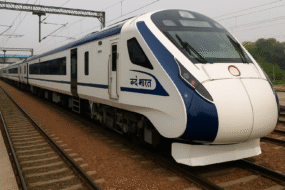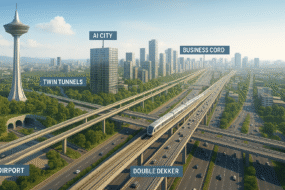Maharashtra is set to usher in a new era of urban mobility with the approval of India’s first pod taxi network, connecting Thane, Navi Mumbai, and Mira-Bhayandar. The project, overseen by the Mumbai Metropolitan Region Development Authority (MMRDA), marks a major leap in the country’s transport modernization efforts.
The approval was finalized during a high-level meeting chaired by Deputy Chief Minister Eknath Shinde, reports Pune Mirror. The project will function under a public-private partnership (PPP) model, with private firms expected to bring advanced technology and investment. Feasibility studies have been completed, and the detailed planning phase is currently underway.
What Are Pod Taxis?
Pod taxis, or Personal Rapid Transit (PRT), are compact, automated, driverless vehicles designed for fast, point-to-point travel. Key features include:
- Small electric pods seating 3–6 passengers
- Elevated, dedicated tracks without traffic interference
- On-demand travel with no intermediate stops
- Low noise, zero-emission transport ideal for congested cities
- Enhanced safety with minimal human involvement
Globally, similar systems operate in the UAE, UK, South Korea, and Japan. The Indian version will be adapted for the region’s high passenger density.
Why This Corridor?
Thane, Navi Mumbai, and Mira-Bhayandar are among the fastest-growing urban pockets in Maharashtra, facing heavy congestion and long travel hours. The pod taxi network aims to:
- Decongest major roads
- Improve last-mile connectivity
- Support existing metro, rail, and bus systems
- Reduce dependence on private vehicles
- Enhance urban air quality
The MMRDA is coordinating with local municipal bodies to identify the most effective pod routes based on traffic patterns and commuter demand.
Seamless Integration with Metro & Buses
A major advantage of the upcoming pod taxi system is its planned integration with Mumbai’s wider transport network. Commuters will be able to move smoothly between pod taxis, metro lines, and buses, sharply reducing overall travel time.
How the PPP Model Helps
The PPP framework is designed to:
- Speed up construction
- Reduce financial pressure on state agencies
- Improve operational efficiency
- Promote adoption of cutting-edge transit technology
Private players will handle building, operating, and maintaining the system, while the MMRDA will serve as the nodal authority.
What Comes Next?
With feasibility studies complete, the next steps include finalizing private partners and initiating construction. Once operational, the pod taxi network is expected to:
- Significantly shorten commute times
- Provide a modern, comfortable travel experience
- Reduce traffic congestion in the region
- Support Maharashtra’s vision of sustainable and smart urban mobility
The project marks a historic milestone and positions Maharashtra at the forefront of India’s futuristic transport innovation.






One reply on “Maharashtra Approves India’s First Pod Taxi Network Linking Thane and Mira-Bhayandar”
[…] Originally published on 24×7-news.com. […]